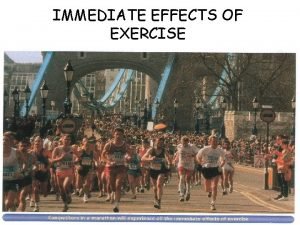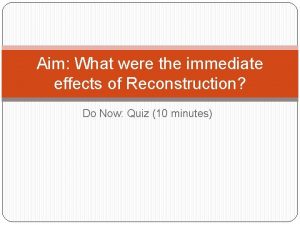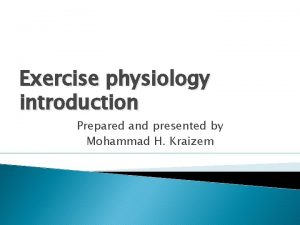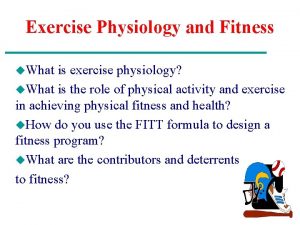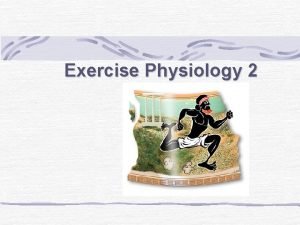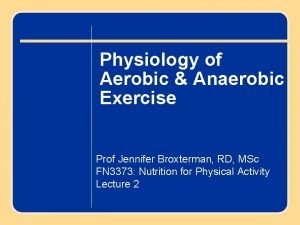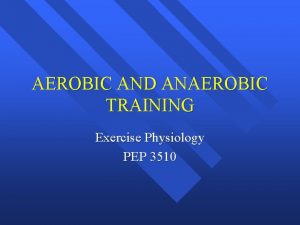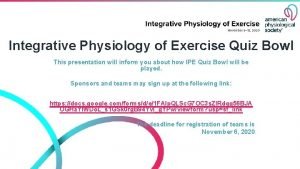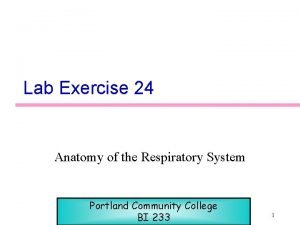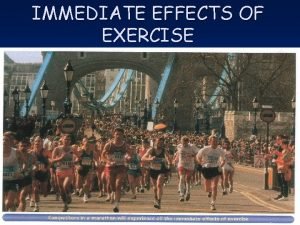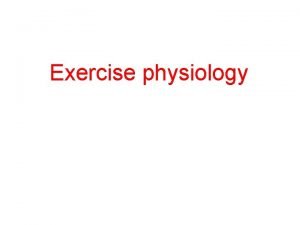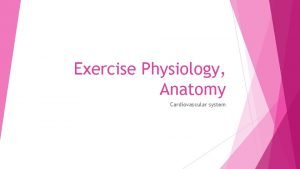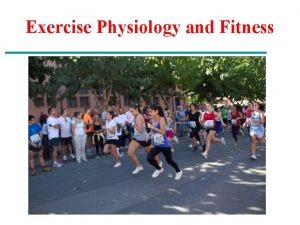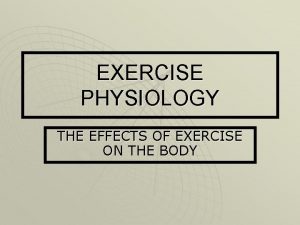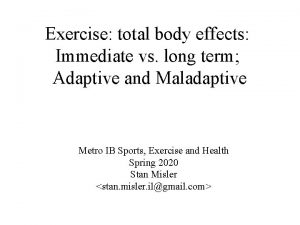PHYSIOLOGY Immediate Effects of Exercise Resources GCSE PE












- Slides: 12

PHYSIOLOGY Immediate Effects of Exercise Resources: GCSE PE for Edexcel

Immediate Effects of Exercise Complete page 53 & 54 in workbook. Qs 1, 2 & 3 on physiological responses to exercise

Heart Beats Faster • Adrenaline which is released during exercise causes the heart rate to quicken. • Blood is also diverted to the working muscles supplying them with more oxygen.

Breathing Rate Increases • No matter how fast the heart beats it cannot carry enough oxygen if an insufficient supply is getting to the lungs. • With training, the lung capacity increases meaning more air, and hence oxygen can be taken in each breath. • Your breathing rate increases to try to get more oxygen into lungs which can then be taken by the blood to the working muscles

Body Temperature Increases • When exercising our muscles are working and are therefore generating heat. • The normal temperature in humans is 37^C.

Sweating • Is the bodies way of regulating our core body temperature and trying to keep it at 37^C. • When we exercise our body temperature rises and we begin to sweat. • This comes out the pores in the skin and when it reaches the surface it evaporates. • For it to evaporate heat is needed and this heat comes from the body. • This helps the body temperature to then fall and cool us down.

Muscles Ache • When we are exercising the muscles are doing extra work and therefore need more glucose and oxygen as fuel. • Eventually it is impossible to get enough oxygen to the muscles, so the body uses the anaerobic system for energy. • Glucose is still used but a waste product of this system is lactic acid which makes the muscles ache and cramp.

Skin Changes Colour • When you exercise your blood vessels dilate (get bigger) to allow heat to escape. • The skin becomes flushed or red due to this

Immediate Effects of Exercise • Complete the following table • Summarize what you just wrote down • BUT…. . Do it with out using your book

Immediate Effects of Exercise Physiological Response 1. Sweating 2. 3. 4. 5. 6. Explain: What happens/ WHY? Helps to remove extra heat generated by muscle action

Physiological Changes in the Body in Response to a Workout Physiological Response Explanation WHY 2. Heart Rate Increases Gets blood & therefore oxygen around the body faster to the working muscles Gets more oxygen into the lungs so it can be taken by the blood to the working muscles Working muscles generate excess heat by the muscle action 3. Breathing Rate Inc. 4. Body Temp Inc

Physiological Response 5. Skin colour changes Explanation WHY Blood vessels dilate to allow heat to escape, and the skin becomes red or flushed 6. Muscles Ache Not enough oxygen is getting to the working muscles so anaerobic energy system is used which causes lactic acid to build up as a by product (You will learn about this soon)
 Immediate effects of exercise
Immediate effects of exercise What were the immediate effects of reconstruction
What were the immediate effects of reconstruction Pediatric exercise physiology
Pediatric exercise physiology Meaning of exercise physiology
Meaning of exercise physiology Wolters kluwer
Wolters kluwer Isotonic exercise physiology
Isotonic exercise physiology 2 types of exercise
2 types of exercise Myeloma uk forum
Myeloma uk forum Exercise intro chapter 1
Exercise intro chapter 1 Pep 3510a
Pep 3510a Physiology of sport and exercise 5th edition
Physiology of sport and exercise 5th edition Exercise physiology quiz
Exercise physiology quiz Tidal volume
Tidal volume
